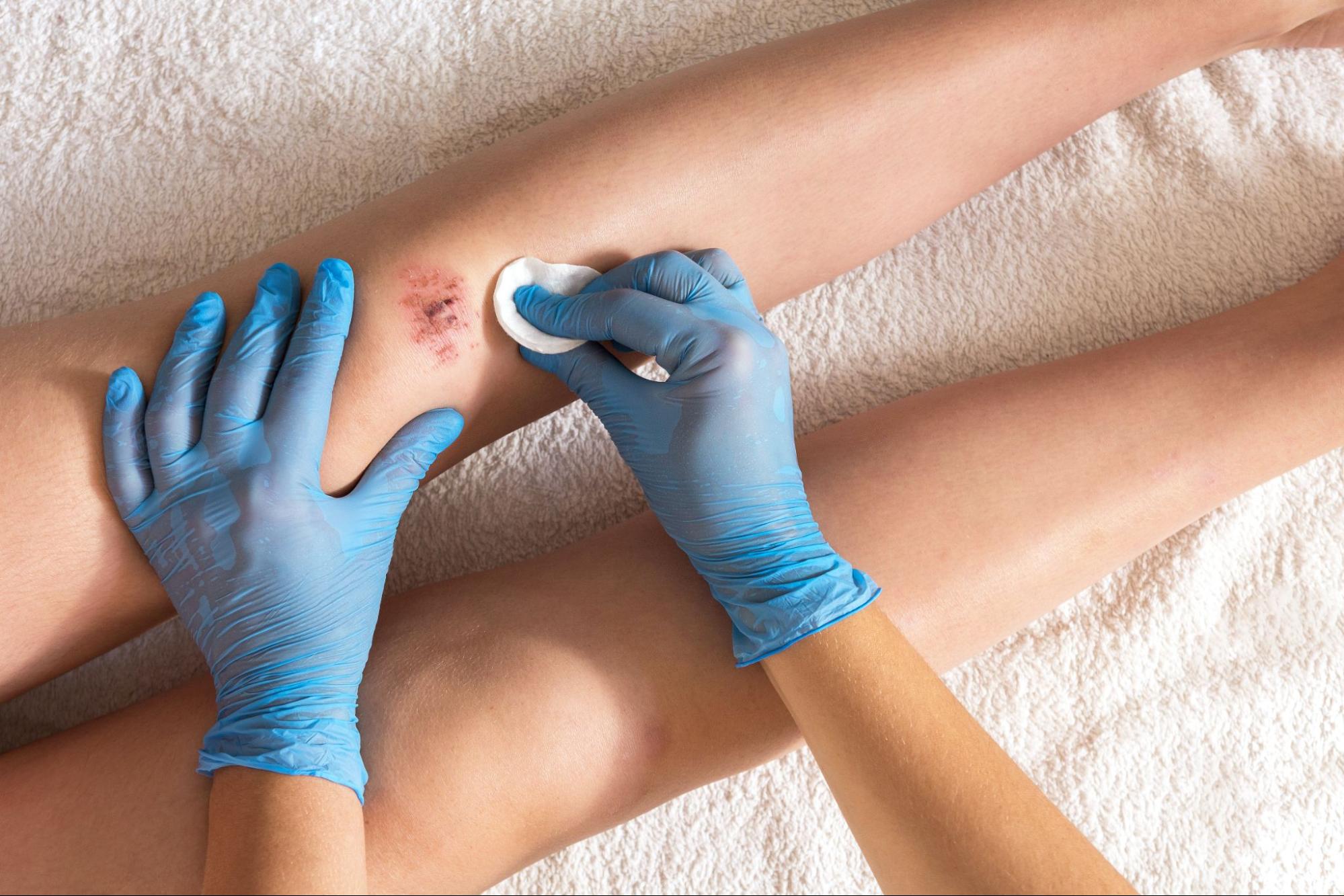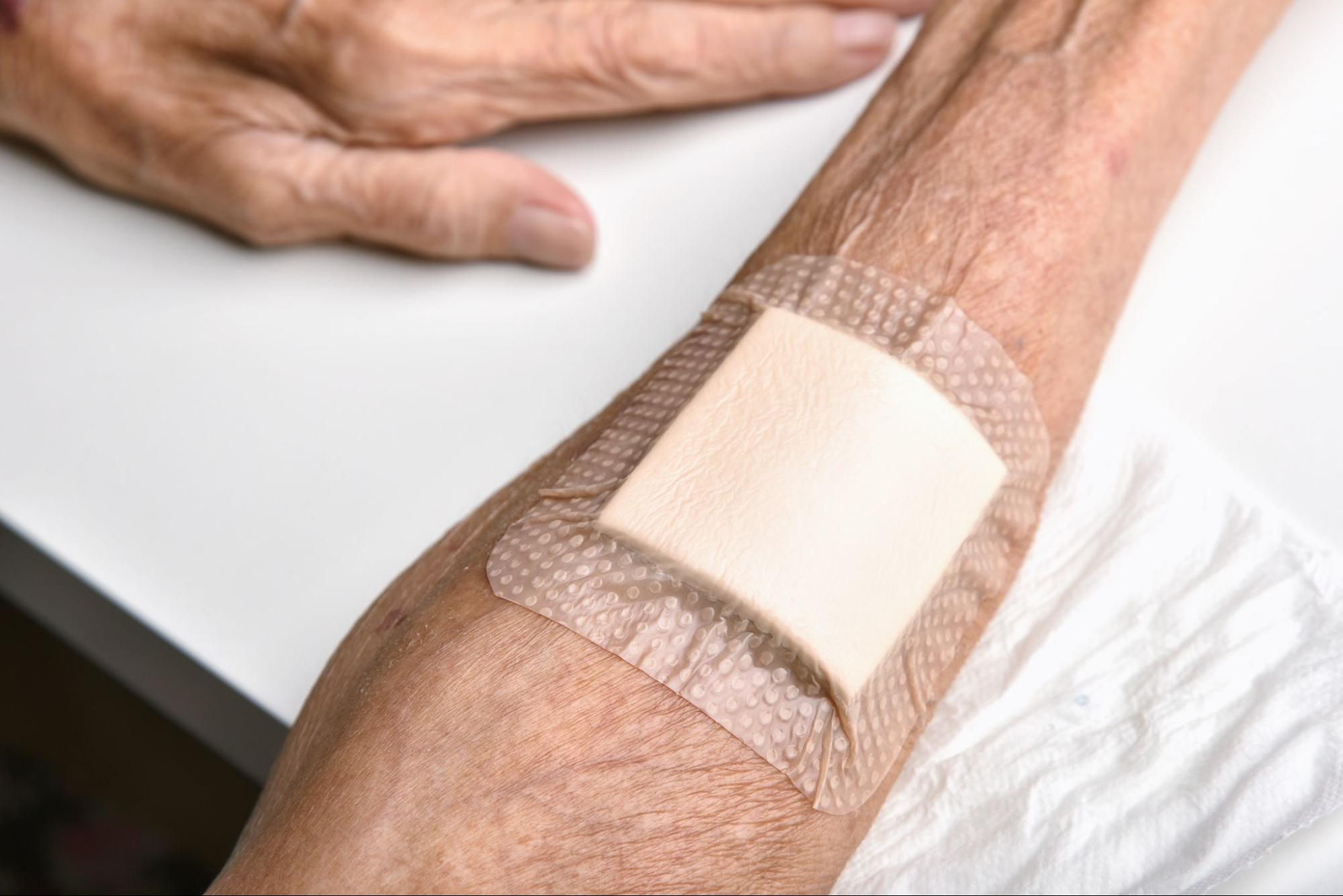
What is a Chronic Wound?
Wounds are a natural part of the body’s healing process, but they become chronic when they fail to heal within an expected timeframe. Unlike acute wounds, which heal within a few weeks, chronic wounds persist for months or years, often requiring specialized care to prevent complications. These wounds can result from underlying health conditions, infections, or poor circulation, making them a significant concern for medical professionals and patients. This comprehensive blog will explore chronic wounds, their causes, symptoms, risk factors, and treatment options. Understanding chronic wounds is essential for ensuring proper wound care and preventing long-term health complications.
Understanding Chronic Wounds
A chronic wound is a wound that does not progress through the normal stages of healing within 30 days. Instead of following the natural cycle of inflammation, tissue formation, and remodeling, these wounds stall due to various biological and external factors.
The Normal Wound Healing Process
To understand why some wounds become chronic, it’s essential to recognize how routine wound healing works:
Stage One: Hemostasis
The body forms a clot to prevent further bleeding and protect the wound. Platelets gather at the injury site, releasing clotting factors that initiate healing. This stage is crucial for stopping blood loss and creating a stable foundation for tissue repair.
Stage Two: Inflammation
White blood cells rush to the wound to fight infection and clear out damaged tissue. The body triggers redness, swelling, and warmth as part of the natural immune response. Essential growth factors and proteins prepare the wound for new tissue formation during this stage.
Stag Three: Proliferation
New cells multiply rapidly, filling in the wound and forming granulation tissue. Fibroblasts help produce collagen, which strengthens the newly forming skin. Blood vessels also regenerate at this stage to supply oxygen and nutrients to the healing tissue.
Stage Four: Maturation
The wound gradually closes as collagen fibers realign and strengthen. Scar tissue forms and the new skin becomes more resilient over time. This final stage can last for months or even years, depending on the severity of the wound.
When this healing process is interrupted, a wound becomes chronic, remaining open and vulnerable to infection.
Common Causes of Chronic Wounds
Several factors can contribute to chronic wound development, including medical conditions and environmental influences.
1. Poor Circulation
Reduced blood flow prevents oxygen and nutrients from reaching the wound, slowing healing. Common conditions that impair circulation include:
Diabetes
Diabetes leads to poor blood flow, which slows the body’s ability to heal wounds effectively. High blood sugar levels can damage nerves, reduce sensations, and make it harder to detect injuries. Additionally, people with diabetes are at a higher risk of infections, which can further complicate wound healing.
Peripheral Artery Disease (PAD)
Peripheral artery disease (PAD) narrows blood vessels, restricting circulation to the extremities. Reduced oxygen and nutrient supply slow the healing process, increasing the risk of chronic wounds. In severe cases, PAD can lead to tissue death, increasing the likelihood of amputation.
Venous Insufficiency
Venous insufficiency causes blood to pool in the legs, leading to swelling and increased pressure in the veins. Over time, this can damage the skin and surrounding tissue, resulting in chronic ulcers. Without proper management, these ulcers can become infected and difficult to heal.
2. Infection
When bacteria invade a wound, it can prevent proper healing and cause further tissue damage. Signs of infection include:
Increased Pain or Swelling
Persistent or worsening pain around a wound may indicate an infection or delayed healing. Swelling occurs as the body responds to inflammation, but excessive swelling can restrict blood flow and slow recovery. If pain and swelling continue to worsen, medical attention may be necessary.
Pus or Foul-Smelling Discharge
The presence of pus or a foul odor from the wound is a strong sign of infection. Pus is a thick fluid that contains dead white blood cells, bacteria, and tissue debris. A foul smell often indicates bacterial overgrowth, which requires prompt treatment to prevent further complications.
Red Streaks or Warmth Around the Wound
Red streaks extending from a wound may signal the spread of infection through the lymphatic system. Warmth around the wound suggests increased blood flow due to inflammation, but persistent heat may indicate an underlying disease. If red streaks or warmth are accompanied by fever, immediate medical care is advised.
3. Repetitive Trauma or Pressure
Wounds subjected to constant pressure, friction, or irritation struggle to heal. Examples include:
Pressure Ulcers (Bedsores)
Pressure ulcers, also known as bedsores, occur when prolonged pressure on the skin restricts blood flow. They are most common in immobile patients who remain in the same position for extended periods, such as those confined to beds or wheelchairs. Without proper care, these ulcers can deepen, leading to severe tissue damage and infection.
Diabetic Foot Ulcers
Diabetic foot ulcers develop due to nerve damage (neuropathy) and pressure from walking. Reduced sensation in the feet makes it difficult for people with diabetes to notice injuries, allowing wounds to worsen over time. Poor circulation further slows healing, increasing the risk of infection and, in severe cases, amputation.

4. Weakened Immune System
A compromised immune system slows healing and makes wounds more susceptible to infection. Causes include:
Chronic Illnesses
Conditions such as cancer, autoimmune diseases, and HIV weaken the immune system, making it harder for the body to fight infections and heal wounds. These illnesses often lead to prolonged inflammation, disrupting the normal healing process. As a result, individuals with chronic diseases are more prone to developing persistent wounds that require specialized care.
Poor Nutrition
A lack of essential vitamins and proteins can significantly slow the body’s ability to repair damaged tissue. Vitamin C, zinc, and protein are crucial for cell regeneration and wound healing. Wounds may take longer to close without proper nutrition, increasing the risk of complications.
Certain Medications
Some medications, including steroids and chemotherapy drugs, can impair the body’s ability to heal wounds. Steroids suppress inflammation, which is necessary for the early stages of healing, while chemotherapy weakens the immune system. Patients taking these medications must take extra precautions to prevent infections and support wound recovery.
5. Excessive Inflammation
Inflammation is a normal part of healing, but prolonged inflammation prevents proper tissue formation. Chronic wounds often remain in a persistent inflammatory state, making healing difficult.
Types of Chronic Wounds
Chronic wounds come in different forms, each with unique causes and treatment approaches.
Pressure Ulcers (Bedsores)
Pressure ulcers, also known as bedsores, occur when prolonged pressure on the skin restricts blood flow. They are most common in immobile patients who remain in the same position for extended periods, such as those confined to beds or wheelchairs. These ulcers can deepen without proper care, leading to severe tissue damage and infection.
Diabetic Ulcers
Diabetic ulcers are open sores that form primarily on the feet of individuals with diabetes due to a combination of poor circulation, nerve damage (neuropathy), and high blood sugar levels. Since diabetes can reduce sensation in the feet, minor cuts or blisters often go unnoticed and worsen over time.
Venous Ulcers
Venous ulcers occur when poor circulation in the veins, typically in the lower legs, prevents blood from flowing efficiently back to the heart. This results in fluid buildup, swelling, and increased pressure in the veins, which weakens the skin and leads to ulcer formation.
Arterial Ulcers
Arterial ulcers develop due to blocked or narrowed arteries, which restrict blood flow to tissues, depriving them of oxygen and essential nutrients needed for healing. They are commonly found on the feet, toes, or ankles and often have a distinctive punched-out appearance with well-defined edges.
Surgical Wounds That Fail to Heal
While most surgical wounds follow a standard healing process, some fail to close correctly due to infection, poor circulation, or a weakened immune system. Post-surgical wounds that remain open for an extended period may indicate an underlying issue requiring medical intervention.
Symptoms of Chronic Wounds
Recognizing chronic wound symptoms early helps prevent severe complications like infections or amputations. Not all wounds heal at the same rate, and some may take longer than expected to close. Early recognition of the signs of a chronic wound can help prevent complications and ensure proper treatment.
Healing Takes Longer Than Four Weeks
A wound that remains open for more than four weeks without significant improvement is considered chronic. Routine healing follows a predictable timeline, but if a wound lingers, it may indicate an underlying issue such as poor circulation, infection, or repeated trauma.
Persistent Pain or Redness Around the Wound
Pain and redness are common in the early stages of healing, but when they persist or worsen, they may signal inflammation or infection. Chronic wounds often remain in a prolonged inflammatory state, preventing new tissue formation.
Swelling, Foul Odor, or Pus Discharge
Excessive swelling, a strong odor, or pus draining from a wound are clear indicators of infection. Infected wounds contain bacteria that cause tissue breakdown and delay recovery. A foul smell often means dead tissue is present, while pus indicates an active immune response.
Blackened Tissue
When tissue turns black or dark brown around a wound, it suggests necrosis, a condition in which cells die due to an insufficient oxygen supply. Necrosis typically occurs in wounds caused by arterial disease, diabetes, or severe infections.
Visible Bone or Tendons in Severe Cases
Chronic wounds can extend deep enough to expose underlying structures such as bones, tendons, or muscles in extreme cases, indicating a severe wound, often associated with diabetic ulcers, pressure sores, or advanced infections.
Treatment and Management of Chronic Wounds
Treating chronic wounds requires a comprehensive approach that addresses the underlying cause, infection prevention, and proper wound care.
1. Wound Cleaning and Debridement
Debridement is a critical process that removes dead or infected tissue, allowing healthy cells to grow and promoting faster healing. Using antiseptic solutions helps keep wounds clean, reducing the risk of infection and complications.
2. Specialized Dressings and Bandages
Hydrocolloid dressings create a moist healing environment, which helps speed up tissue regeneration and prevent scabbing. Foam dressings absorb excess fluids, reducing the risk of infection, while compression bandages improve circulation, particularly in venous ulcers.
3. Infection Management
Topical and oral antibiotics eliminate bacterial infections, ensuring that wounds do not worsen or become systemic. Additionally, antimicrobial dressings infused with silver or iodine help prevent bacterial growth, providing long-term protection against infection.
4. Managing Underlying Conditions
Proper diabetes management through diet, medication, and regular monitoring helps prevent chronic wounds. Similarly, improving circulation with exercise or medications can enhance blood flow, reducing the risk of slow-healing wounds associated with PAD or venous disease.
5. Advanced Wound Healing Therapies
For stubborn wounds, doctors may use:
Hyperbaric Oxygen Therapy
Hyperbaric oxygen therapy (HBOT) increases oxygen levels in the bloodstream, helping tissues receive the oxygen needed for faster healing. This treatment is particularly beneficial for chronic wounds with poor circulation, as it reduces inflammation, promotes new cell growth, and lowers the risk of infection.
Skin Grafts and Amniotic Grafts
Skin grafts replace damaged or non-healing skin with healthy donor tissue to accelerate wound closure. Amniotic grafts, derived from placental tissue, provide a natural healing scaffold rich in growth factors, helping stimulate tissue regeneration and reduce inflammation in chronic wounds.
Negative Pressure Wound Therapy
Negative pressure wound therapy (NPWT) uses suction to remove excess fluid, reduce swelling, and promote blood flow to the wound. NPWT and amniotic grafts can enhance new tissue formation and improve overall wound recovery by creating a controlled healing environment.
Preventing Chronic Wounds
Proper wound care and overall health management are crucial in preventing wounds from becoming chronic.
1. Maintain Proper Hygiene
Keeping skin clean and dry prevents infections and irritation.
2. Manage Health Conditions
Control diabetes, vascular disease, and immune disorders to prevent complications.
3. Avoid Prolonged Pressure
Change positions frequently if immobile or bedridden to prevent pressure ulcers.
4. Wear Proper Footwear
For people with diabetes, well-fitted shoes reduce the risk of foot ulcers.

Understanding Chronic Wound, Wound Care, and Treatment
Chronic wounds are more than just slow-healing injuries—they are complex medical conditions that require specialized care and attention. Whether caused by poor circulation, diabetes, infection, or repeated pressure, these wounds can lead to serious complications if not treated properly. Understanding risk factors, early warning signs, and treatment options can significantly improve healing outcomes. If you or a loved one is dealing with a chronic wound, seek medical advice to ensure proper care and prevention. With advancements in wound care, managing chronic wounds has become more effective than ever. By addressing underlying conditions and practicing good wound care, individuals can improve healing times and reduce infection risks, leading to a better quality of life.
For more expert insights, innovative treatment solutions, and the latest advancements in regenerative medicine, visit the Stem Health Plus blog today! Learn how cutting-edge therapies can help accelerate healing and improve wound care outcomes.
